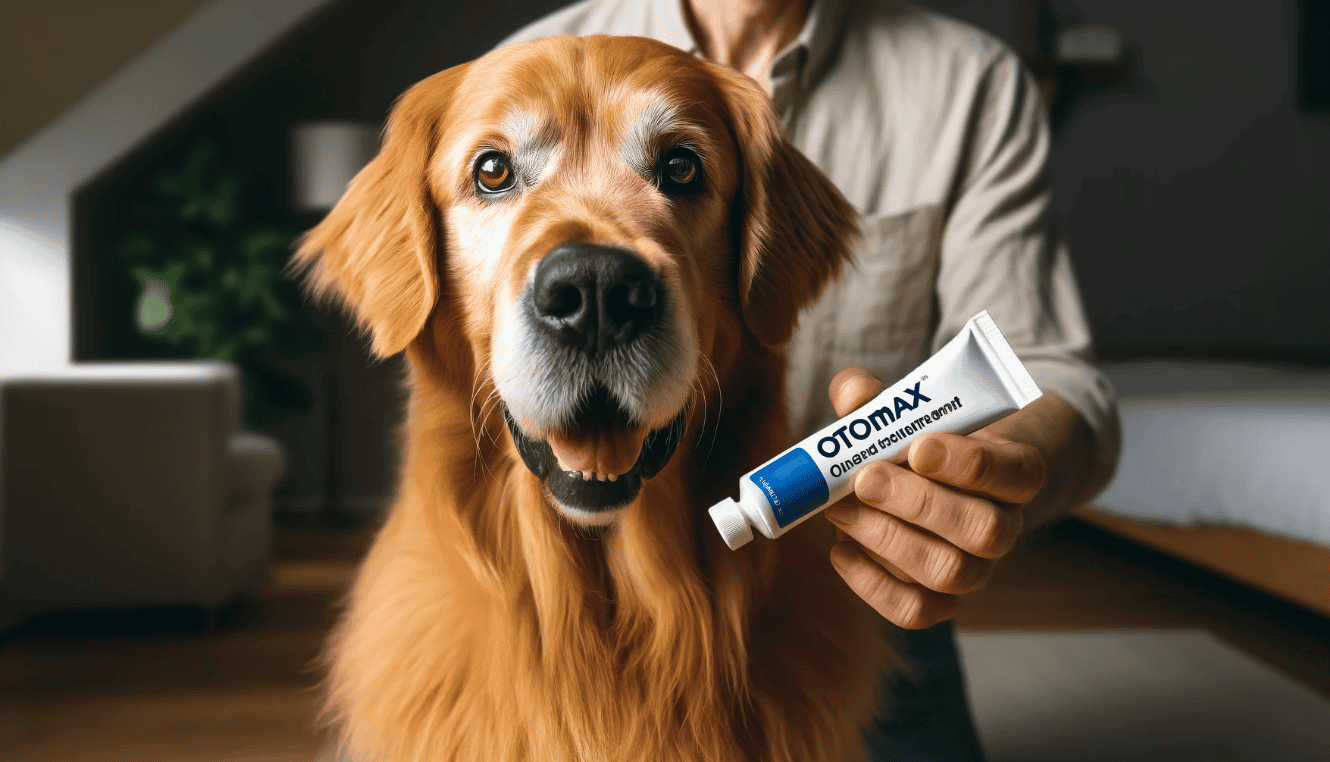Hello, I’m Dr. Candy Akers, and I’ve dedicated my life to understanding the intricate world of veterinary medicine. Over the years, I’ve encountered countless cases that have both challenged my expertise and deepened my passion for animal care. One such topic that often arises in my practice is the use of medications, specifically Otomax, for our beloved pets. It’s crucial for pet owners to be well-informed about the treatments they administer, understanding not just the benefits but also the potential risks. In this blog, I aim to shed light on Otomax, its ingredients, its uses, and its alternatives. My goal is to provide you with a comprehensive guide, rooted in professional experience and scientific knowledge, so you can make the best decisions for your furry family members. Let’s embark on this informative journey together.

What is Otomax?
Otomax is primarily formulated to treat acute and chronic otitis externa, an inflammation of the outer ear canal. Otitis externa can be caused by yeast, bacterial infections, or both. The combination of ingredients in Otomax makes it a potent treatment against the inflammation, bacterial, and fungal infections commonly found in cases of otitis externa.
However, like all medications, Otomax should be used with caution and under the guidance of a veterinarian. It’s essential to ensure that the eardrum is intact before administering the ointment, as the medication can be harmful if it reaches the middle or inner ear.
Key Ingredients of Otomax Ointment: A Comprehensive List
Otomax is a prescription ointment used primarily in veterinary medicine, specifically for dogs. It’s a combination medication that contains three active ingredients:
- Betamethasone: This is a corticosteroid that helps reduce inflammation, itching, and redness. It’s particularly effective in reducing the swelling and discomfort associated with certain skin conditions.
- Clotrimazole: An antifungal agent, clotrimazole is effective against a variety of fungal infections. It’s commonly used to treat yeast infections in a dog’s ear, which can be a frequent issue for some breeds.
- Gentamicin: This is an antibiotic that fights against a wide range of bacteria. When used in combination with the other ingredients in Otomax, it can help treat bacterial infections that might accompany or exacerbate fungal infections.
Otomax is a multifunctional ointment designed to combat a range of ear-related issues in dogs. Its combination of anti-inflammatory, antifungal, and antibiotic properties make it a go-to for many veterinarians when treating otitis externa. However, as with all treatments, understanding its uses, benefits, and potential side effects is crucial for the well-being of our pets.
The Primary Uses: What is Otomax Ointment Used For?
Otomax ointment is a versatile medication that has been formulated to address a range of ear-related issues in dogs. Its unique combination of ingredients makes it particularly effective for several conditions:
- Otitis Externa Treatment: The primary use of Otomax is to treat acute and chronic otitis externa. Otitis externa refers to the inflammation of the external ear canal. This condition can be particularly uncomfortable for dogs, leading to symptoms like itching, redness, swelling, and discharge. The causes can range from bacterial to fungal infections or even a combination of both. Otomax’s three active ingredients work in tandem to combat these infections and reduce inflammation, providing relief to the affected animals.
- Bacterial Infections: The gentamicin in Otomax is effective against a variety of bacteria, making the ointment a suitable treatment for bacterial infections in the ear. This includes infections caused by Pseudomonas aeruginosa and Staphylococcus aureus, among others.
- Fungal Infections: Dogs can sometimes develop fungal or yeast infections in their ears, especially in warm, humid conditions. The clotrimazole in Otomax targets these fungal pathogens, particularly those caused by the Candida and Malassezia (previously known as Pityrosporum) species.
- Anti-Inflammatory Properties: Dogs with ear infections often experience significant discomfort due to inflammation. The betamethasone in Otomax acts as an anti-inflammatory agent, reducing swelling, redness, and pain in the ear canal.
It’s important to note that while Otomax is effective for the conditions mentioned above, it should always be used under the guidance of a veterinarian. Proper diagnosis is crucial to ensure that the medication addresses the underlying issue and doesn’t exacerbate any existing conditions. Additionally, regular monitoring during treatment is essential to track the pet’s progress and ensure no adverse reactions occur.
Know Your Ingredients: The Science Behind Otomax
Otomax is more than just a simple ointment; it’s a carefully formulated combination of ingredients, each playing a crucial role in treating various ear conditions in dogs. Let’s delve deeper into the science behind each of these components.
1. Betamethasone
Betamethasone is a corticosteroid, a class of steroids that are known for their potent anti-inflammatory properties. When applied topically:
- Mechanism of Action: Betamethasone works by suppressing the inflammatory response at a cellular level. It does this by inhibiting the release of inflammatory mediators and reducing the dilation of blood vessels.
- Benefits: This ingredient helps reduce symptoms like redness, swelling, itching, and pain, which are common in conditions like otitis externa.
- Considerations: While effective, corticosteroids like betamethasone can have side effects if used excessively or for prolonged periods. It’s essential to follow the veterinarian’s prescribed dosage and duration.
2. Clotrimazole
Clotrimazole is an antifungal agent that’s effective against a variety of fungal species.
- Mechanism of Action: Clotrimazole targets the cell membrane of fungi, disrupting its structure and leading to the death of the fungal cell.
- Benefits: It’s particularly effective against yeast infections in dogs’ ears, which can be caused by fungi like Candida and Malassezia.
- Considerations: While clotrimazole is generally safe, it’s essential to ensure that the eardrum is intact before applying any medication containing this ingredient.
3. Gentamicin
Gentamicin is an aminoglycoside antibiotic known for its broad-spectrum activity against various bacteria.
- Mechanism of Action: Gentamicin works by binding to bacterial ribosomes, inhibiting protein synthesis and leading to bacterial cell death.
- Benefits: It’s effective against several bacteria, including Pseudomonas aeruginosa and Staphylococcus aureus, which can cause ear infections in dogs.
- Considerations: As with all antibiotics, it’s crucial to complete the full course of treatment, even if symptoms improve, to prevent antibiotic resistance.
Understanding the science behind Otomax’s ingredients provides a clearer picture of how this ointment works and why it’s effective for treating various ear conditions in dogs. Each ingredient has been carefully chosen for its specific action, and together, they offer a comprehensive solution for ear infections and inflammations. As always, it’s essential to consult with a veterinarian before starting any treatment to ensure the safety and well-being of our furry friends.

Cautions When Using Otomax: Safety First
While Otomax is a powerful and effective ointment for treating various ear conditions in dogs, it’s essential to approach its use with caution. Like all medications, there are specific guidelines and potential risks that pet owners should be aware of to ensure their pet’s safety and well-being.
1. Intact Eardrum is Crucial
Before administering Otomax, it’s imperative to ensure that the dog’s eardrum is intact. If the eardrum is ruptured and the medication reaches the middle or inner ear, it can lead to complications, including hearing loss or balance issues.
2. Follow the Prescribed Dosage
Always adhere to the dosage and duration recommended by the veterinarian. Overuse or prolonged use of Otomax can lead to potential side effects, including increased risk of secondary infections or resistance to the antibiotic component.
3. Monitor for Allergic Reactions
While rare, some dogs might be allergic to one or more of the ingredients in Otomax. Signs of an allergic reaction include increased redness, swelling, itching, or any unusual behavior. If you suspect an allergic reaction, discontinue use and consult your veterinarian immediately.
4. Avoid Contact with Eyes
Otomax is formulated for ear use only. If it accidentally comes into contact with the eyes, it can cause irritation. In such cases, rinse the eyes thoroughly with clean water and seek veterinary advice.
5. Store Properly
Keep Otomax in a cool, dry place, away from direct sunlight. Ensure it’s out of reach of children and pets to prevent accidental ingestion or misuse.
6. Do Not Use Expired Medication
Always check the expiration date before using Otomax. Using expired medication can reduce its effectiveness and may even be harmful.
7. Consultation for Pregnant or Lactating Dogs
If your dog is pregnant or lactating, consult with your veterinarian before using Otomax. The effects of the medication on unborn or nursing puppies are not well-documented, so it’s best to approach with caution.
Otomax, while beneficial, should be used responsibly and with an understanding of its potential risks. By following the recommended guidelines and being aware of the cautions, pet owners can ensure that their dogs receive the best care while minimizing potential side effects. Always prioritize your pet’s safety and consult with a veterinarian if you have any concerns or questions about Otomax or any other medication.

Exploring Safer Alternatives: Best Over-The-Counter Substitute to Otomax
Dr. Candy’s Recommendation
While Otomax is a trusted prescription ointment for treating various ear conditions in dogs, there are instances where pet owners might be looking for over-the-counter (OTC) alternatives. Whether it’s due to concerns about potential side effects, the desire for a more natural approach, or simply the convenience of OTC availability, it’s essential to know your options. One such notable alternative is the Zymox Veterinarian Strength Topical Cream with 1% Hydrocortisone for Dogs.
Zymox Veterinarian Strength Topical Cream with 1% Hydrocortisone for Dogs
Zymox is a reputable brand in the pet care industry, known for its enzyme-based products that tackle a range of infections.
- Active Ingredient: The primary active ingredient in this topical cream is hydrocortisone, which is a corticosteroid. At a 1% concentration, it effectively reduces inflammation, itching, and redness associated with skin conditions.
- Enzyme-Based Approach: Zymox products are known for their patented LP3 Enzyme System. This system uses a combination of enzymes to combat bacterial, fungal, and yeast infections without the use of antibiotics.
- Benefits:
- Natural Defense: The enzymes in Zymox products mimic the body’s natural defense mechanism, making them a more natural approach to treating infections.
- Reduced Risk of Resistance: Since Zymox doesn’t rely on antibiotics, there’s a reduced risk of bacteria developing resistance.
- Safe for Regular Use: Zymox is gentle enough for regular use, making it suitable for chronic conditions or as a preventive measure.
- Usage: It’s essential to follow the instructions on the product label or consult with a veterinarian for the best results. Generally, the cream is applied once a day for 7 to 14 days, depending on the severity of the condition.
Other OTC Alternatives
While Zymox is a prominent alternative, there are other OTC products available that might suit different needs or preferences. Always ensure that you research each product thoroughly and consult with a veterinarian before making a switch.
Choosing the right treatment for your pet is a crucial decision that impacts their comfort and well-being. While Otomax is a powerful prescription ointment, it’s reassuring to know that there are effective OTC alternatives like Zymox Veterinarian Strength Topical Cream available. As always, prioritize your pet’s safety and well-being, and don’t hesitate to seek professional advice when exploring new treatments.

Conclusion
In the world of pet care, the choices we make for our furry companions can feel overwhelming. From the food they eat to the toys they play with, and most importantly, the medications they take – every decision impacts their well-being. As a dedicated pet owner, you’re always on the lookout for the best options, seeking knowledge that ensures your pet’s health and happiness. I hope that you feel confident in your knowledge of options and the use of Otomax.
Frequently Asked Questions
Answer: If the eardrum is ruptured and Otomax reaches the middle or inner ear, it can lead to complications such as hearing loss, balance issues, or deeper infections. Always have a veterinarian check the eardrum’s integrity before starting any ear medication.
Answer: Yes, there are natural remedies like apple cider vinegar solutions, coconut oil, and herbal extracts that some pet owners use for minor ear issues. However, it’s crucial to consult with a veterinarian before trying any home remedies to ensure they’re safe and appropriate for your pet’s condition.
Answer: While many dogs show improvement within a few days of starting treatment, the duration can vary based on the severity of the condition. Always follow the recommended treatment course and consult with your veterinarian if you don’t notice any improvement within a week.
Answer: Otomax is primarily formulated for dogs. Using it for other animals without a veterinarian’s guidance can be risky. Always consult with a veterinarian before administering any medication to pets other than dogs.
Answer: It’s essential to consult with a veterinarian before re-administering Otomax, even if your dog has used it in the past. The symptoms might look similar, but the underlying cause could be different. Using the ointment without a proper diagnosis might not address the issue and could even exacerbate it.
